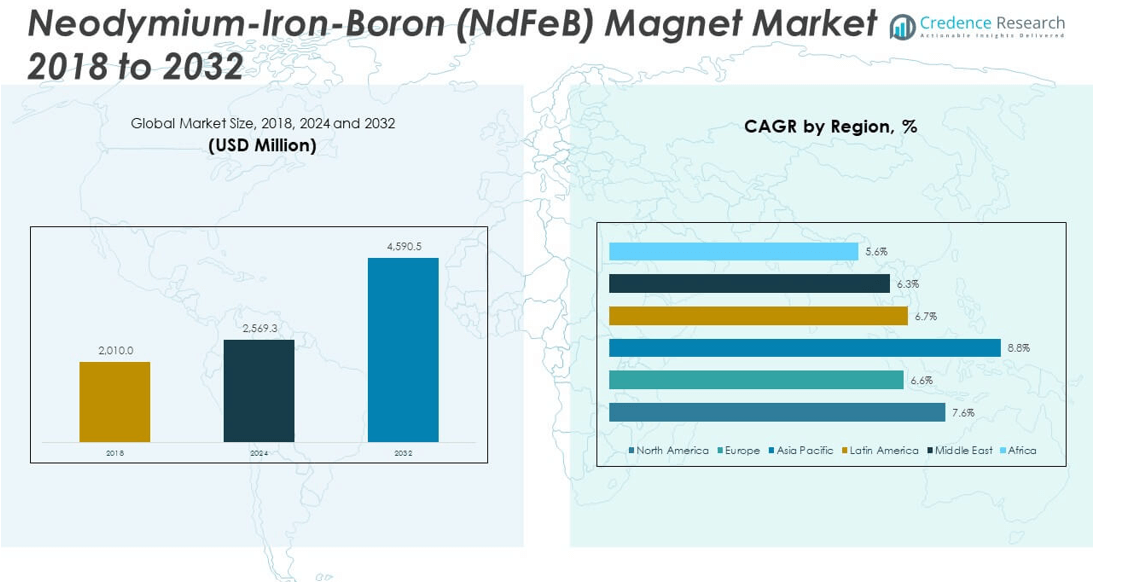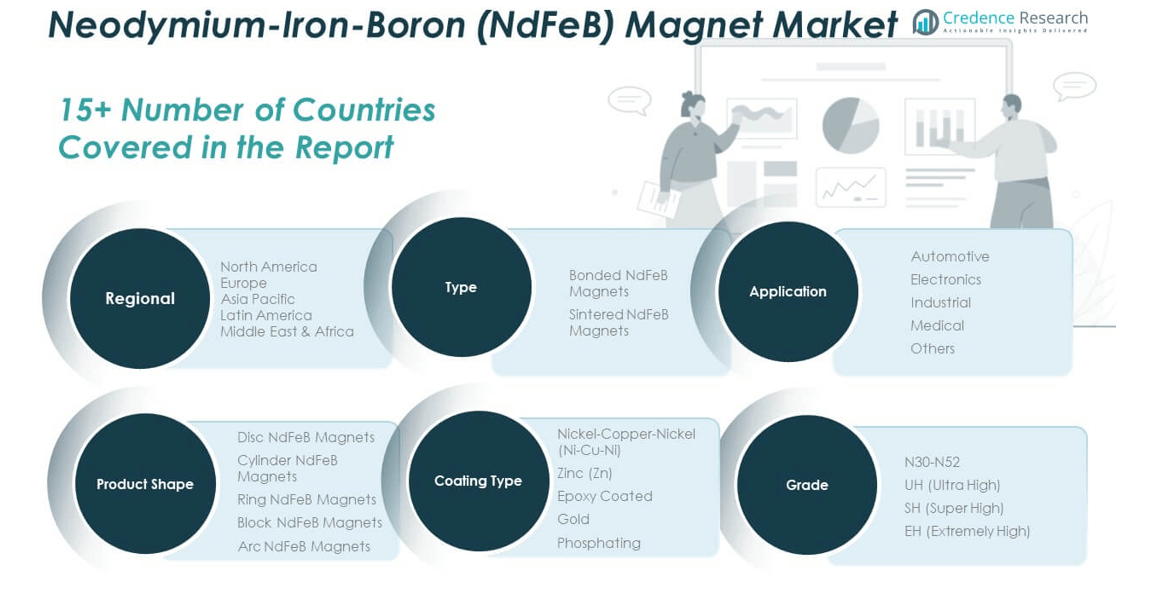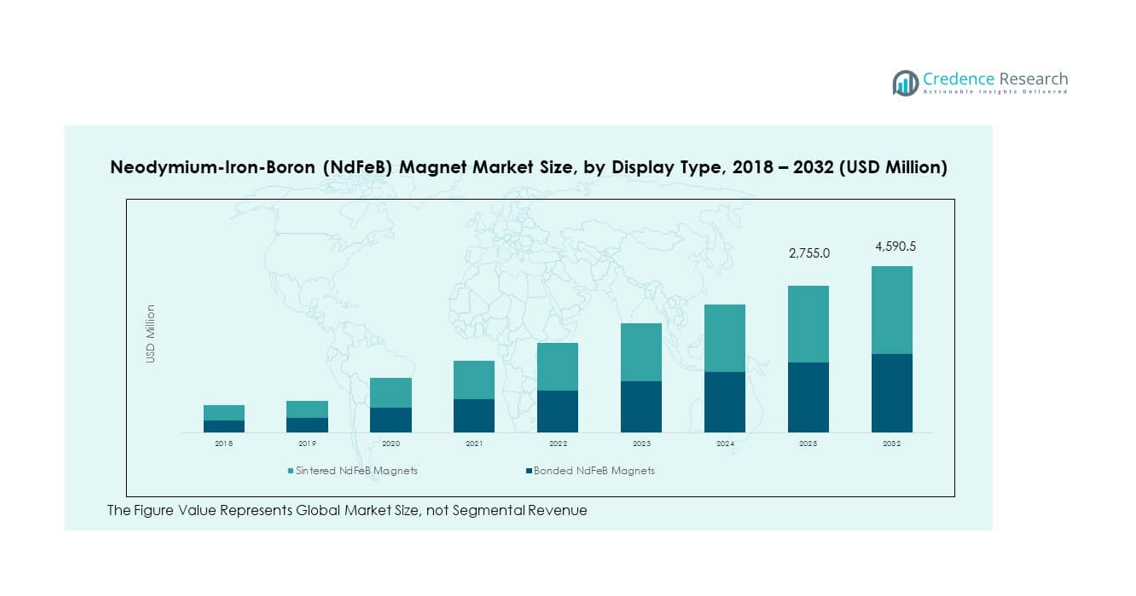CHAPTER NO. 1 : GENESIS OF THE MARKET
1.1 Market Prelude – Introduction & Scope
1.2 The Big Picture – Objectives & Vision
1.3 Strategic Edge – Unique Value Proposition
1.4 Stakeholder Compass – Key Beneficiaries
CHAPTER NO. 2 : EXECUTIVE LENS
2.1 Pulse of the Industry – Market Snapshot
2.2 Growth Arc – Revenue Projections (USD Million)
2.3. Premium Insights – Based on Primary Interviews
CHAPTER NO. 3 : NEODYMIUM-IRON-BORON (NDFEB) MAGNET MARKET FORCES & INDUSTRY PULSE
3.1 Foundations of Change – Market Overview
3.2 Catalysts of Expansion – Key Market Drivers
3.2.1 Momentum Boosters – Growth Triggers
3.2.2 Innovation Fuel – Disruptive Technologies
3.3 Headwinds & Crosswinds – Market Restraints
3.3.1 Regulatory Tides – Compliance Challenges
3.3.2 Economic Frictions – Inflationary Pressures
3.4 Untapped Horizons – Growth Potential & Opportunities
3.5 Strategic Navigation – Industry Frameworks
3.5.1 Market Equilibrium – Porter’s Five Forces
3.5.2 Ecosystem Dynamics – Value Chain Analysis
3.5.3 Macro Forces – PESTEL Breakdown
3.6 Price Trend Analysis
3.6.1 Regional Price Trend
3.6.2 Price Trend by product
CHAPTER NO. 4 : KEY INVESTMENT EPICENTER
4.1 Regional Goldmines – High-Growth Geographies
4.2 Product Frontiers – Lucrative Product Categories
4.3 Deployment Sweet Spots – Emerging Demand Segments
CHAPTER NO. 5: REVENUE TRAJECTORY & WEALTH MAPPING
5.1 Momentum Metrics – Forecast & Growth Curves
5.2 Regional Revenue Footprint – Market Share Insights
5.3 Segmental Wealth Flow – Type & Deployment Revenue
CHAPTER NO. 6 : TRADE & COMMERCE ANALYSIS
6.1. Import Analysis by Region
6.1.1. Global Neodymium-Iron-Boron (NdFeB) Magnet Market Import Revenue By Region
6.2. Export Analysis by Region
6.2.1. Global Neodymium-Iron-Boron (NdFeB) Magnet Market Export Revenue By Region
CHAPTER NO. 7 : COMPETITION ANALYSIS
7.1. Company Market Share Analysis
7.1.1. Global Neodymium-Iron-Boron (NdFeB) Magnet Market: Company Market Share
7.2. Global Neodymium-Iron-Boron (NdFeB) Magnet Market Company Revenue Market Share
7.3. Strategic Developments
7.3.1. Acquisitions & Mergers
7.3.2. New Product Launch
7.3.3. Regional Expansion
7.4. Competitive Dashboard
7.5. Company Assessment Metrics, 2024
CHAPTER NO. 8 : NEODYMIUM-IRON-BORON (NDFEB) MAGNET MARKET – BY TYPE SEGMENT ANALYSIS
8.1. Neodymium-Iron-Boron (NdFeB) Magnet Market Overview by Type Segment
8.1.1. Neodymium-Iron-Boron (NdFeB) Magnet Market Revenue Share By Type
8.2. Bonded NdFeB Magnets
8.3. Sintered NdFeB Magnets
CHAPTER NO. 9 : NEODYMIUM-IRON-BORON (NDFEB) MAGNET MARKET – BY APPLICATION SEGMENT ANALYSIS
9.1. Neodymium-Iron-Boron (NdFeB) Magnet Market Overview by Grade Segment
9.1.1. Neodymium-Iron-Boron (NdFeB) Magnet Market Revenue Share By Grade
9.2. Automotive
9.3. Electronics
9.4. Industrial
9.5. Medical
9.6. Others
CHAPTER NO. 10 : NEODYMIUM-IRON-BORON (NDFEB) MAGNET MARKET – BY PRODUCT SHAPE SEGMENT ANALYSIS
10.1. Neodymium-Iron-Boron (NdFeB) Magnet Market Overview by Product Shape Segment
10.1.1. Neodymium-Iron-Boron (NdFeB) Magnet Market Revenue Share By Product Shape
10.2. Disc NdFeB Magnets
10.3. Cylinder NdFeB Magnets
10.4. Ring NdFeB Magnets
10.5. Block NdFeB Magnets
10.6. Arc NdFeB Magnets
CHAPTER NO. 11 : NEODYMIUM-IRON-BORON (NDFEB) MAGNET MARKET – BY COATING TYPE SEGMENT ANALYSIS
11.1. Neodymium-Iron-Boron (NdFeB) Magnet Market Overview by Coating Type Segment
11.1.1. Neodymium-Iron-Boron (NdFeB) Magnet Market Revenue Share By Coating Type
11.2. Nickel-Copper-Nickel (Ni-Cu-Ni)
11.3. Zinc (Zn)
11.4. Epoxy Coated
11.5. Gold
11.6. Phosphating
CHAPTER NO. 12 : NEODYMIUM-IRON-BORON (NDFEB) MAGNET MARKET – BY GRADE SEGMENT ANALYSIS
12.1. Neodymium-Iron-Boron (NdFeB) Magnet Market Overview by Grade Segment
12.1.1. Neodymium-Iron-Boron (NdFeB) Magnet Market Revenue Share By Grade
12.2. N30-N52
12.3. UH (Ultra High)
12.4. SH (Super High)
12.5. EH (Extremely High)
CHAPTER NO. 13 : NEODYMIUM-IRON-BORON (NDFEB) MAGNET MARKET – REGIONAL ANALYSIS
13.1. Neodymium-Iron-Boron (NdFeB) Magnet Market Overview by Region Segment
13.1.1. Global Neodymium-Iron-Boron (NdFeB) Magnet Market Revenue Share By Region
13.1.2. Regions
13.1.3. Global Neodymium-Iron-Boron (NdFeB) Magnet Market Revenue By Region
13.1.4. Type
13.1.5. Global Neodymium-Iron-Boron (NdFeB) Magnet Market Revenue By Type
13.1.6. Deployment
13.1.7. Global Neodymium-Iron-Boron (NdFeB) Magnet Market Revenue By Deployment
13.1.8. Product Shape
13.1.9. Global Neodymium-Iron-Boron (NdFeB) Magnet Market Revenue By Product Shape
13.1.10. Coating Type
13.1.12. Global Neodymium-Iron-Boron (NdFeB) Magnet Market Revenue By Coating Type
13.1.13. Grade
13.1.14. Global Neodymium-Iron-Boron (NdFeB) Magnet Market Revenue By Grade
CHAPTER NO. 14 : NORTH AMERICA NEODYMIUM-IRON-BORON (NDFEB) MAGNET MARKET – COUNTRY ANALYSIS
14.1. North America Neodymium-Iron-Boron (NdFeB) Magnet Market Overview by Country Segment
14.1.1. North America Neodymium-Iron-Boron (NdFeB) Magnet Market Revenue Share By Region
14.2. North America
14.2.1. North America Neodymium-Iron-Boron (NdFeB) Magnet Market Revenue By Country
14.2.2. Type
14.2.3. North America Neodymium-Iron-Boron (NdFeB) Magnet Market Revenue By Type
14.2.4. Application
14.2.5. North America Neodymium-Iron-Boron (NdFeB) Magnet Market Revenue By Application
14.2.6. Product Shape
14.2.7. North America Neodymium-Iron-Boron (NdFeB) Magnet Market Revenue By Product Shape
14.2.8. Coating Type
14.2.9. North America Neodymium-Iron-Boron (NdFeB) Magnet Market Revenue By Coating Type
14.2.10. Grade
14.2.11. North America Neodymium-Iron-Boron (NdFeB) Magnet Market Revenue By Grade
14.3. U.S.
14.4. Canada
14.5. Mexico
CHAPTER NO. 15 : EUROPE NEODYMIUM-IRON-BORON (NDFEB) MAGNET MARKET – COUNTRY ANALYSIS
15.1. Europe Neodymium-Iron-Boron (NdFeB) Magnet Market Overview by Country Segment
15.1.1. Europe Neodymium-Iron-Boron (NdFeB) Magnet Market Revenue Share By Region
15.2. Europe
15.2.1. Europe Neodymium-Iron-Boron (NdFeB) Magnet Market Revenue By Country
15.2.2. Type
15.2.3. Europe Neodymium-Iron-Boron (NdFeB) Magnet Market Revenue By Type
15.2.4. Application
15.2.5. Europe Neodymium-Iron-Boron (NdFeB) Magnet Market Revenue By Application
15.2.6. Product Shape
15.2.7. Europe Neodymium-Iron-Boron (NdFeB) Magnet Market Revenue By Product Shape
15.2.8. Coating Type
15.2.9. Europe Neodymium-Iron-Boron (NdFeB) Magnet Market Revenue By Coating Type
15.2.10. Grade
15.2.11. Europe Neodymium-Iron-Boron (NdFeB) Magnet Market Revenue By Grade
15.3. UK
15.4. France
15.5. Germany
15.6. Italy
15.7. Spain
15.8. Russia
15.9. Rest of Europe
CHAPTER NO. 16 : ASIA PACIFIC NEODYMIUM-IRON-BORON (NDFEB) MAGNET MARKET – COUNTRY ANALYSIS
16.1. Asia Pacific Neodymium-Iron-Boron (NdFeB) Magnet Market Overview by Country Segment
16.1.1. Asia Pacific Neodymium-Iron-Boron (NdFeB) Magnet Market Revenue Share By Region
16.2. Asia Pacific
16.2.1. Asia Pacific Neodymium-Iron-Boron (NdFeB) Magnet Market Revenue By Country
16.2.2. Type
16.2.3. Asia Pacific Neodymium-Iron-Boron (NdFeB) Magnet Market Revenue By Type
16.2.4. Application
16.2.5. Asia Pacific Neodymium-Iron-Boron (NdFeB) Magnet Market Revenue By Application
16.2.6. Product Shape
16.2.7. Asia Pacific Neodymium-Iron-Boron (NdFeB) Magnet Market Revenue By Product Shape
16.2.8. Coating Type
16.2.9. Asia Pacific Neodymium-Iron-Boron (NdFeB) Magnet Market Revenue By Coating Type
16.2.10. Grade
16.2.11. Asia Pacific Neodymium-Iron-Boron (NdFeB) Magnet Market Revenue By Grade
16.3. China
16.4. Japan
16.5. South Korea
16.6. India
16.7. Australia
16.8. Southeast Asia
16.9. Rest of Asia Pacific
CHAPTER NO. 17 : LATIN AMERICA NEODYMIUM-IRON-BORON (NDFEB) MAGNET MARKET – COUNTRY ANALYSIS
17.1. Latin America Neodymium-Iron-Boron (NdFeB) Magnet Market Overview by Country Segme
17.1.1. Latin America Neodymium-Iron-Boron (NdFeB) Magnet Market Revenue Share By Region
17.2. Latin America
17.2.1. Latin America Neodymium-Iron-Boron (NdFeB) Magnet Market Revenue By Country
17.2.2. Type
17.2.3. Latin America Neodymium-Iron-Boron (NdFeB) Magnet Market Revenue By Type
17.2.4. Application
17.2.5. Latin America Neodymium-Iron-Boron (NdFeB) Magnet Market Revenue By Application
17.2.6. Product Shape
17.2.7. Latin America Neodymium-Iron-Boron (NdFeB) Magnet Market Revenue By Product Shape
17.2.8. Coating Type
17.2.9. Latin America Neodymium-Iron-Boron (NdFeB) Magnet Market Revenue By Coating Type
17.2.10. Grade
17.2.11. Latin America Neodymium-Iron-Boron (NdFeB) Magnet Market Revenue By Grade
17.3. Brazil
17.4. Argentina
17.5. Rest of Latin America
CHAPTER NO. 18 : MIDDLE EAST NEODYMIUM-IRON-BORON (NDFEB) MAGNET MARKET – COUNTRY ANALYSIS
18.1. Middle East Neodymium-Iron-Boron (NdFeB) Magnet Market Overview by Country Segment
18.1.1. Middle East Neodymium-Iron-Boron (NdFeB) Magnet Market Revenue Share By Region
18.2. Middle East
18.2.1. Middle East Neodymium-Iron-Boron (NdFeB) Magnet Market Revenue By Country
18.2.2. Type
18.2.3. Middle East Neodymium-Iron-Boron (NdFeB) Magnet Market Revenue By Type
18.2.4. Application
18.2.5. Middle East Neodymium-Iron-Boron (NdFeB) Magnet Market Revenue By Application
18.2.6. Product Shape
18.2.7. Middle East Neodymium-Iron-Boron (NdFeB) Magnet Market Revenue By Product Shape
18.2.8. Coating Type
18.2.9. Middle East Neodymium-Iron-Boron (NdFeB) Magnet Market Revenue By Coating Type
18.2.10. Grade
18.2.11. Middle East Neodymium-Iron-Boron (NdFeB) Magnet Market Revenue By Grade
18.3. GCC Countries
18.4. Israel
18.5. Turkey
18.6. Rest of Middle East
CHAPTER NO. 19 : AFRICA NEODYMIUM-IRON-BORON (NDFEB) MAGNET MARKET – COUNTRY ANALYSIS
19.1. Africa Neodymium-Iron-Boron (NdFeB) Magnet Market Overview by Country Segment
19.1.1. Africa Neodymium-Iron-Boron (NdFeB) Magnet Market Revenue Share By Region
19.2. Africa
19.2.1. Africa Neodymium-Iron-Boron (NdFeB) Magnet Market Revenue By Country
19.2.2. Type
19.2.3. Africa Neodymium-Iron-Boron (NdFeB) Magnet Market Revenue By Type
19.2.4. Application
19.2.5. Africa Neodymium-Iron-Boron (NdFeB) Magnet Market Revenue By Application
19.2.6. Product Shape
19.2.7. Africa Neodymium-Iron-Boron (NdFeB) Magnet Market Revenue By Product Shape
19.2.8. Coating Type
19.2.9. Africa Neodymium-Iron-Boron (NdFeB) Magnet Market Revenue By Coating Type
19.2.10. Grade
19.2.11. Africa Neodymium-Iron-Boron (NdFeB) Magnet Market Revenue By Grade
19.3. South Africa
19.4. Egypt
19.5. Rest of Africa
CHAPTER NO. 20 : COMPANY PROFILES
20.1. Hitachi Metals Ltd.
20.1.1. Company Overview
20.1.2. Product Portfolio
20.1.3. Financial Overview
20.1.4. Recent Developments
20.1.5. Growth Strategy
20.1.6. SWOT Analysis
20.2. Molycorp, Inc.
20.3. China Northern Rare Earth Group High-Tech Co.
20.4. Lynas Corporation
20.5. Shin-Etsu Chemical Co. Ltd.
20.6. TDK Corporation
20.7. Electron Energy Corporation
20.8. Stella Group
20.9. Zhongtai International Holdings Limited
20.10. ArcelorMittal
20.11. South China Sea Rare Earth Group
20.12. Ningbo Zhongtai New Materials Co., Ltd.






